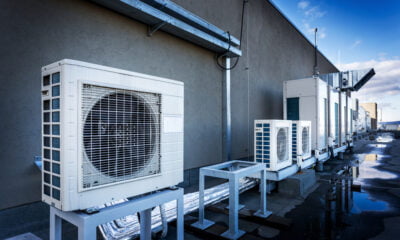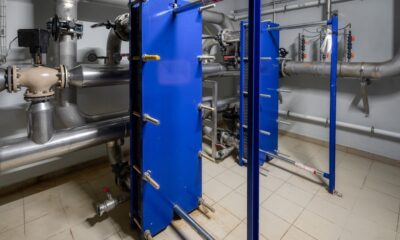If you want to get smart about your home’s energy efficiency, it’s time to upgrade. Today’s newest home technologies use Wi-Fi connections, smart programming, and even artificial intelligence to conserve your home’s energy use. These smart home devices can make your home more sustainable, all while offsetting their cost through energy savings. They’re a no-brainer if you’re looking to make your home as efficient as possible.
The Smart Home Industry Takes Off
If something in your home is powered by electricity, there’s a good chance there’s a smart version on the market. Smart home automation has taken off in the US—the “Internet of Things” marketplace is expected to top $470 billion by 2020. This massive growth is thanks in part to the strong return many homeowners get on their investment.
Smart home devices run more efficiently than their analog counterparts, making them significantly more energy efficient over time. Smart devices also offer a number of other conveniences, from smarter programming routines to voice-activated controls. You can even control all your devices from a smart hub or home security system.
The Best Smart Home Upgrades for Home Efficiency
Not all smart devices are created equal. These are the best upgrades to invest in for cost and energy savings over time, and they allow for advanced home automation routines and voice controls. They each offer their own benefits as well, so they’ll do fine as standalone upgrades if you’re not ready to go all in with every device.
1. Smart Thermostats
A smart thermostat is the most obvious choice for energy efficiency. As the “brain” of your heating and cooling system, this handy device regulates the temperature of your house using sensors, schedules, and basic artificial intelligence algorithms. Over time, a smart thermostat will learn your preferences and begin to replicate your heating and cooling changes automatically, ensuring that your home stays at your preferred temperature.
Smart thermostats can significantly improve the efficiency of your home. They’ll automatically turn down your heat or AC when you leave the house, and most use local weather data to automatically compensate for natural temperature variations. The Nest home automation manufacturer released a study that estimated a 10%–12% increase in heating efficiency, and a 15% increase in cooling efficiency for the average owner of a smart thermostat. These numbers translate to an average of $131–$145 in cost savings per year.
2. Smart Lightbulbs
Lighting accounts for 15% of the world’s electricity use and 5% of global emissions. If your home is stuck in the past with fluorescent or CFL lightbulbs, an upgrade to your lighting can put a serious dent in your consumption. You can program your smart lightbulbs to coordinate with your other smart home devices and even sync with apps on your phone.
A smart lightbulb’s automated routines can ensure you’ll never forget to turn off the lights when you leave the house. The best lightbulbs can even replicate your lighting habits when you’re on vacation, increasing your home’s security. Switching to LED lightbulbs can mean using at least 75% less energy for your lights.
3. Smart Appliances
Large appliances make up a considerable part of your home’s energy budget. Your refrigerator, oven, microwave, washing machine, dryer, and dishwasher can account for 16% or more of your total electricity bill. The percentage can be even greater if your appliances are old and inefficient.
Many smart home appliances are ENERGY STAR rated for efficiency. Replacing every appliance in the US with an ENERGY STAR rated appliance would reduce greenhouse gas emissions by the equivalent of taking 215,000 cars off the road. Certified appliances can also grant you a tax reduction, compounding your total cost savings.
4. Smart Ceiling Fans
Space-cooling appliances are the largest electricity consumer by percentage in US homes. A window unit air conditioner can use up to 1,440 watts, and central air systems might use double that amount. A simple electric fan is much more efficient, and a smart ceiling fan goes even further to increase your home’s comfort and energy efficiency.
Smart ceiling fans like the Haiku series are up to four times more efficient than the current ENERGY STAR rankings and boast intelligent energy-saving features. The Haiku has an occupancy sensor, so it operates only when necessary—and it can even mimic cool breezes through variable fan speeds. If the price tag of this high-end option leaves you spinning, consider installing a smart switch for your current ceiling fan instead.
Conclusion
Almost any home can be upgraded with smart controls for heating, cooling, and electricity use. The ease of use for these smart home devices makes it easy to reduce your energy consumption without a noticeable change in your lifestyle. In fact, many of these products can make your life a little bit easier with the added benefit of helping the planet too.


 Environment10 months ago
Environment10 months agoAre Polymer Banknotes: an Eco-Friendly Trend or a Groundswell?

 Environment12 months ago
Environment12 months agoEco-Friendly Home Improvements: Top 7 Upgrades for 2025

 Features9 months ago
Features9 months agoEco-Friendly Cryptocurrencies: Sustainable Investment Choices

 Features10 months ago
Features10 months agoEco-Friendly Crypto Traders Must Find the Right Exchange






























